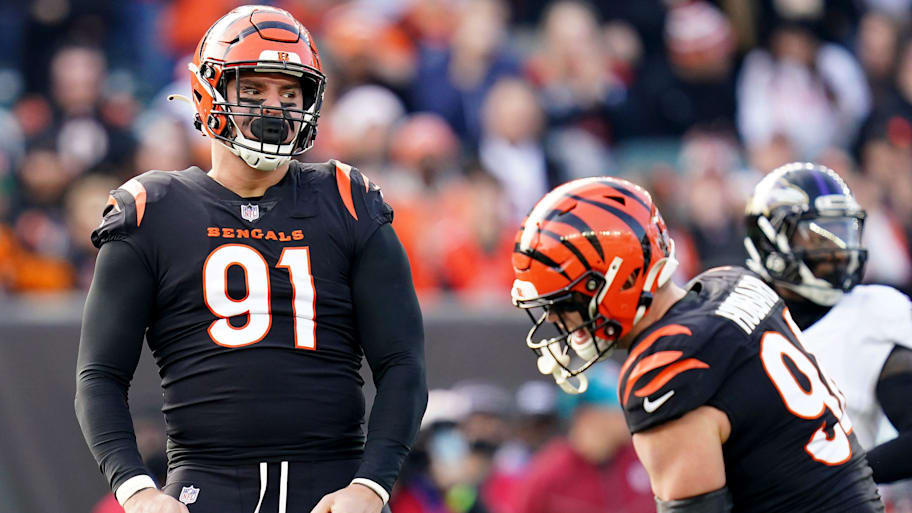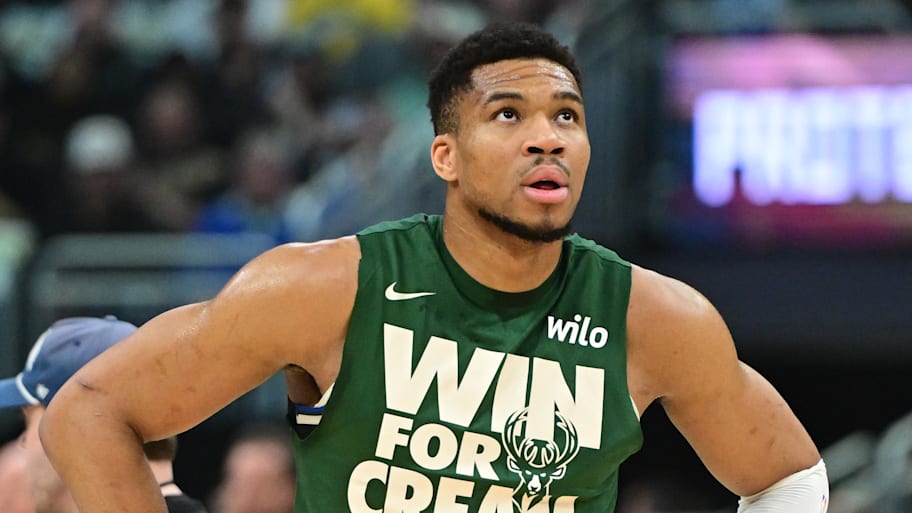Giannis Antetokounmpo and Trey Hendrickson were born one day and an ocean apart in the first week of December 1994. They are now both elite professional athletes, but in a sense, they remain an ocean apart.
Antetokounmpo, the Milwaukee Bucks superstar, is under contract for three more years with a player option, at more than $54 million per year. But his camp is now planting stories about him being “open-minded about exploring whether his best long-term fit is remaining in Milwaukee,” and we know how these stories tend to go in the NBA. He will either get traded to a team that appeals to him, or he will pressure the Bucks to make changes he desires. One way or the other, the Bucks will capitulate.
Hendrickson, the Cincinnati Bengals’ All-Pro defensive end, is under contract for one more year at $15.8 million. Hendrickson was a finalist for Defensive Player of the Year last season, so naturally, he wants a better deal. He asked for a trade and the Bengals denied it. He complained to ESPN that the Bengals “are no longer communicating” with him about a new contract, and he vowed not to play under his current contract. But we know how these stories tend to go in the NFL. In pro football, pressuring the opposing quarterback is hard, but pressuring your employer is harder.

Antetokounmpo is one of the five best players in the world. Hendrickson is not. Still, the disparity between their situations is so great that it can lead to an obvious conclusion:
The National Basketball Players Association negotiated a labor deal that favors players, and the National Football League Players Association negotiated a deal that favors team owners.
This has been repeated so often that most sports fans seem to accept it as fact.
But it isn’t really true.
The economics of the two leagues have been oversimplified to the point of distortion. This is partly because of antiquated perceptions: The NFL fought off free agency until the 1990s. But it is also due to lazy analysis and cherry-picking data points to create a narrative.
Some facts: NBA players make more money than NFL players, but that is primarily because there are fewer of them.
The 32 NFL teams carry 69 players: 53 on the active roster and up to 16 on practice squads. The 30 NBA teams carry 14 or 15, including inactives. (Yes, NBA teams sometimes leave a roster spot open, meaning there is a job opening that nobody fills, at least temporarily.)
So at any given moment, there are 2,200 players in the NFL and (at most) 450 in the NBA. If you wonder why Bradley Beal makes more than Patrick Mahomes, start there.
NFL players collectively make a lot more than NBA players: According to Spotrac, which tracks franchise spending, NBA teams spent $5.24 billion on player salaries this season. Last fall, NFL teams spent $9.34 billion.
Yes, you say, but the NFL obviously brings in a lot more money. If this is obvious to you and me, then don’t you think NFL players have figured it out?
The NBA sets its salary cap at 44.74% of “Basketball Related Income,” minus projected benefits. The NFL formula for setting the cap is slightly more complex, but no matter what teams spend, there is a mechanism that resets the “Player Cost Amount” (including benefits) at between 48% and 48.5% of annual revenue.
The NBA does have a softer cap, which allows teams to spend above the cap number. But the highest payroll in the NBA (the Minnesota Timberwolves, at $237 million) would still be the lowest in the NFL. When you hear the Golden State Warriors paid more than $400 million for last season’s roster, or the Celtics could pay more than $500 million for next season’s, that’s outlay, not player income. It includes at least $200 million in luxury taxes, which are exempt from Basketball Related Income. That money gets redistributed to other franchises and the league, not to players.
I will not get into a granular comparison of the two leagues’ collective bargaining agreements, because a) I don’t wanna; b) I’m not smart enough; and c) if I were smart enough, I still wouldn’t wanna. There are just too many variables. The NBA’s CBA is 560 pages (plus exhibits!) The NFL’s CBA is 434 pages, though there are more lines per page in the NFL CBA, so even that is not an apples-to-apples comparison.
But we can safely assume that lawyers for both leagues and both players associations have spent considerable time closely examining both CBAs, looking for any clause it could lift. This is reflected in the agreements.
NBA franchises must spend at least 90% of the cap. NFL teams must spend at least 95%. Both leagues have carve-outs for stadium and arena deals.
There are some fundamental differences between the two CBAs. But they are not a reflection of the relative strength of the unions. They are a reflection on the differences between the two sports.
A football field is a much more dangerous workplace than a basketball court. NFL careers end earlier than in the NBA, and at most positions, excellence is harder to sustain. NFL owners expect to spend big on players; they just don’t want to spend big on injured or unproductive players. This is why they are wary of long, guaranteed contracts. They value the ability to move on to a younger, healthier, more productive employee.
Most elite basketball players are great for a long time—and because they are involved in a much higher percentage of plays than anybody in a football game, they have an enormous impact on a team. So NBA owners approach negotiations from a very different place: Left alone with their wallets, they would eagerly sign their best players to long, expensive deals, so they ask commissioner Adam Silver to save them from themselves. The NBA not only has maximum salaries, but it ties those maximums to independent arbiters of player value: media members who decide All-NBA teams.
Just as management has different priorities in different sports, so do the players unions. This, I think, is why the NFLPA has gotten such a bad rap: We view the business of the game primarily for how it affects the entertainment product, and so we notice that players such as Antetokounmpo have enormous leverage and players such as Hendrickson have very little. But the CBA covers a lot of other issues that don’t affect the entertainment product as clearly, yet are important to the membership.
NFL commissioner Roger Goodell wants a wide berth in regards to player discipline, and the union has ceded it to him. This feels like the union caved. But since the vast majority of NFL players do not get suspended, giving Goodell that power doesn’t personally hurt them. They are willing to trade it for something that matters more to them and less to Goodell.
The union also gave Goodell the right to implement a 17th game, which increased its members’ chance of injury. But that also has to be viewed in the context of the whole labor deal.
The “injury grievances” section of basketball’s labor agreement takes up less than a page. That same section in football’s labor agreement is six pages. The outsized physical risk of football is reflected throughout the agreement: players’ rights to medical care and treatment, injury protections, and practice and workout limits are all covered in far greater detail in football’s labor deal, because those issues are larger (and require more negotiating) in football.
In recent years, both unions have prioritized the well-being of former players, which is admirable. However, that task is exponentially larger and more expensive in football. There are more than 10,000 former NFL players in the Pro Football Retired Players Association, while the National Basketball Retired Players Association says it has “more than 1,000”—and, because football is so violent, the average former NFL player needs more medical care than the average former NBA player. For example: Football’s CBA mandates that the “88 Plan” provides up to $185,000 per year for anybody who played three seasons and is diagnosed with ALS, Parkinson’s or dementia. There is no comparable program in the NBA.
We can debate whether the NFL and its union are doing enough for former players. But they are definitely doing more than the NBA and its union, simply because they are dealing with a much larger pool of higher-risk retirees. That comes at a cost.
Now, back to Antetokounmpo and Hendrickson.
Hendrickson will turn 31 on Dec. 5. Antetokounmpo will turn 31 the next day.
Antetokounmpo is under contract for three more years, including a player option, at a guaranteed salary of around $58 million. The Bucks are in a difficult position for a variety of reasons; star Damian Lillard tore his left Achilles tendon, and Milwaukee probably can’t contend next season. But the Bucks’ absolute best asset is Antetokounmpo’s contract. Every team in the league would love to have him at that pay, because he is extremely likely to be worth it.
The NBA’s CBA mandated that the Bucks could sign Antetokounmpo for more than any other team could offer and for less than he would get in a true open market, with no maximum salaries. Now his contract makes him much more valuable on the trade market than if he had one year on his deal. If the Bucks trade him for a bounty that accelerates a rebuild, they can thank the CBA.
Hendrickson is under contract for one more year at $15.8 million. He outperformed that salary last season, and I don’t fault him for trying to get paid more. But Von Miller made his last Pro Bowl at age 30. J.J. Watt, who has publicly supported Hendrickson’s stance, made his last Pro Bowl at 29. The Bengals should be wary of committing now to pay top dollar for Hendrickson’s 2026 and ’27 seasons. Their labor deal is set up to give them options.
The Bengals will spend the money Hendrickson wants; the CBA requires it. But they might not spend it on him. Their reasoning is repeated seven times in the first three paragraphs of the labor agreement:
Football.
This article was originally published on www.si.com as Examining NFL, NBA CBA Differences Through Giannis Antetokounmpo and Trey Hendrickson.
